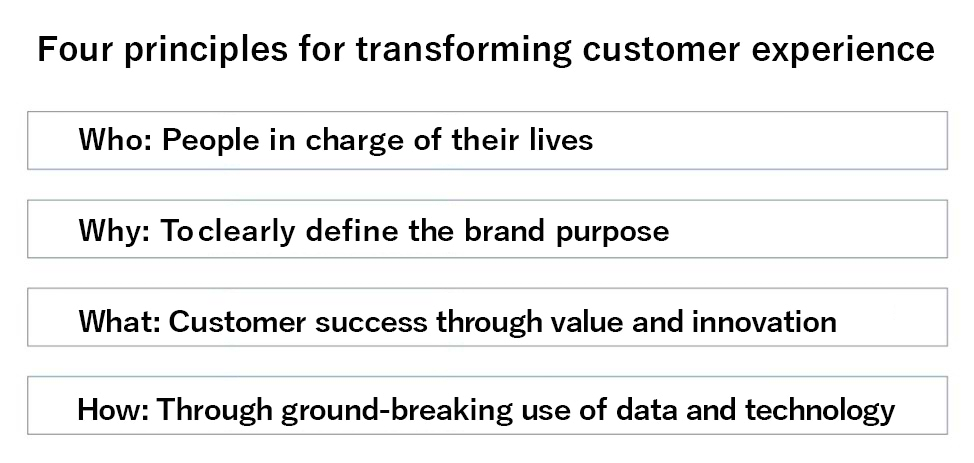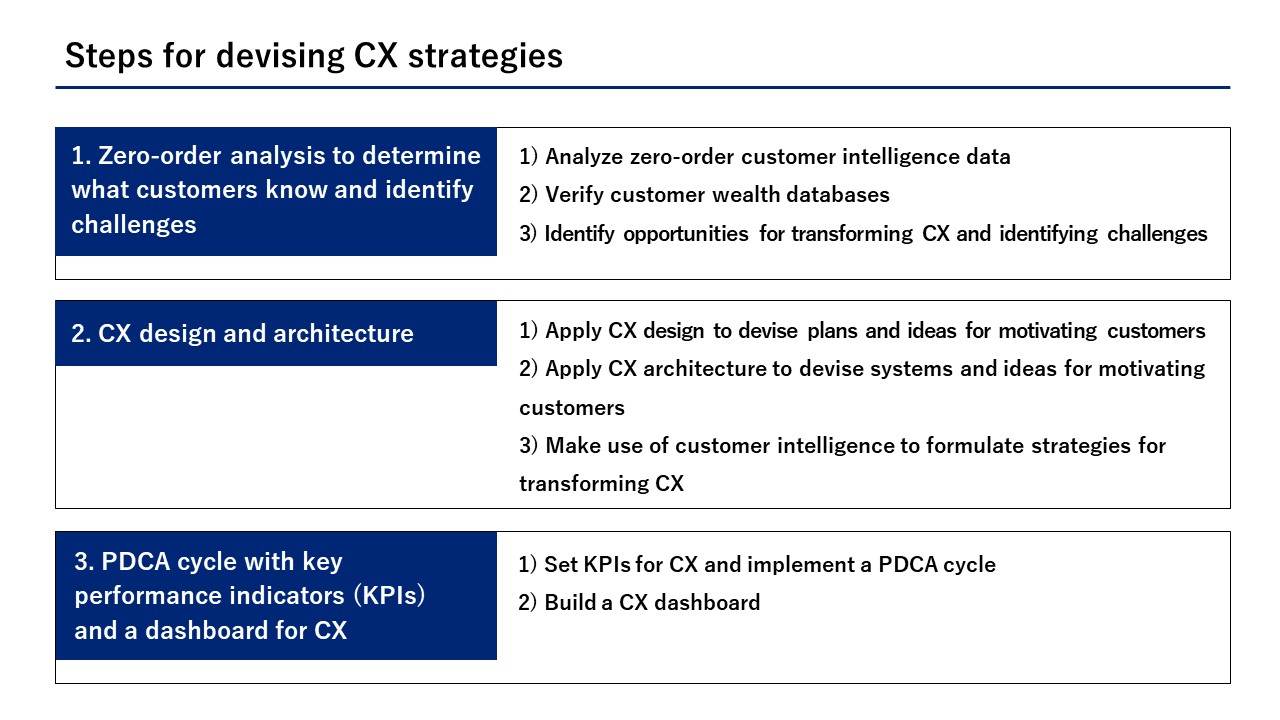
Masafumi Tanizawa
Integrated Solutions Division 1
Senior Solution Director

Chika Mitsui
Integrated Solutions Division 1
Marketing Strategist
The tendency to treat the means as the end when designing customer experiences and digitally transforming
Our efforts, over the past few years, to design customer experiences and promote the digital transformation of Japan have accelerated amid the COVID-19 pandemic. Clients are asking us to explain what customer experience (CX) entails, and expressing a desire for the digital transformation (DX) of their businesses, although they are not sure how to use the data they have.
In our view, their concerns are rooted in a tendency to treat the means as an end. For example, clients typically want to adopt customer relationship management tools to design customer experiences and to use data for its own sake. In other words, the purpose is to apply these means. More importantly, however, we need to begin by considering the essence of the customer experience.
To provide an example of marketing that has successfully captured the essence of the customer experience, we will focus on a campaign for the Kate brand of make-up produced by Kanebo Cosmetics Inc.
The brand purpose of Kate is to reinvent yourself, expressed with the slogan, “No more rules.” The Kate brand encourages users to question common sense about make-up and even how they have previously used make-up. It offers a means for users to express themselves—not only within the confines of make-up but in their lives more generally.
Starting from this brand purpose, and recognizing that opportunities for using make-up have been on the decline during the pandemic, we helped Kanebo Cosmetics develop a series of hit products based on the idea of using make-up even when wearing face masks. The products include small masks and lipstick that does not stick to one’s mask.
Given the decline in store visits during the pandemic, we also helped the client release a face scanning service through the LINE social messaging app, promoting it as a way to capture one’s true self, regardless of rules.
In addition, we issued an online magazine featuring interviews with celebrities who epitomize the idea of no more rules, and created an official YouTube channel showcasing distinctive products presented by the company’s employees. Through these initiatives, the campaign has been creating a customer experience that encourages Kate users to freely express themselves.
Four principles provide keys for transforming CX
We have devised four principles that provide keys for transforming customer experiences. They are explained below, using the example of the Kate marketing campaign.

Who: People in charge of their lives
Kate brand customers express their individuality
Every customer is different. The first step to designing a customer experience is to consider what products and services are useful for each person’s individual life journey, and what can be done to enrich their lives and well-being.
Why: To clearly define the brand purpose
For the Kate brand, No more rules
A brand purpose is the ultimate aim of the brand and its reason for being. By defining this clearly, all things related to the brand can serve as means to an end. Thus, treating the means as the end, as pointed out earlier, is no longer an issue.
What: Customer success through value and innovation
For the Kate brand, this means uplifting experiences with innovative products and content
Customer success comes from a brand’s intention and actions to brighten the lives of customers. By expanding the purpose of the Kate brand beyond the concept of make-up, new products and content can give customers an uplifting experience, allowing them to become whoever they want to be.
How: Through ground-breaking use of data and technology
For the Kate brand, it means ability to engage with the brand during the pandemic through the LINE app
Data and technology can play major roles in helping realize a brand purpose and ensure customer success. This is where the tendency to treat the means as the end is most likely to occur. Therefore, we make sure we integrate the means (data and technology) and purpose throughout the entire customer experience, based on the concept of customer intelligence.
CX strategic framework built on customer intelligence
Customer intelligence is information compiled for the sake of customers, both in order to realize the brand purpose and to ensure customer success. By collecting and analyzing data related to the five categories of segmentation, profiling, insights, journeys, and moments, we can create opportunities for transforming brand-specific customer experiences and identifying related challenges.

An overall framework of customer intelligence strategies.
It is not possible to differentiate a customer experience to reflect the distinctive aspects of a brand just by adopting technologies. Technologies can only improve efficiency. Therefore, we start by designing a customer experience with the ultimate goals of realizing the brand purpose and ensuring customer success.
That alone, however, will just give us the general direction to take. For a business to produce results by transforming the customer experience, we must choose and apply the most effective technologies—a CX platform—from among numerous means of execution.
The customer datasets that make up customer intelligence combine CX design and CX platforms to allow the customer experience to flow organically. By implementing a plan-do-check-act (PDCA) cycle to make use of customer intelligence on a practical level, we can make improvements to CX architecture, and by implementing a PDCA cycle with a broader perspective, we can refine the objectives of CX design, allowing us to create a better customer experience.

Create brand-specific customer experiences by imaginatively applying customer intelligence
One more aspect of the Kate marketing campaign is worth looking at. When marketing ordinary brands, cross-selling and upselling tend to be objectives when executing customer relationship management. In the Kate campaign, however, customer intelligence was incorporated in customer relationship management, and the main objective was to have customers discover their individuality.
For that reason, purchasing data is not the only data to be collected in the customer relationship management process. Content exposure data as well as data derived from social media posts about self-identity are also needed. Devising key indicators for measuring how often customers wish to reinvent themselves is more important than the frequency of their purchases.
Consequently, customer relationship management for the Kate campaign is intended to enrich the experiences of customers rather than to induce them to buy, so the customer experience changes as a matter of course.
Accordingly, by considering the customer and envisioning a path for realizing the brand purpose and customer success, the data that needs to be collected and technologies that should be used become really obvious. This is also how ideas about the distinctiveness of a brand emerge, and the customer experience is transformed into something specific to the brand. In our view, this gets to the heart of the customer experience.
Nowadays, people live much longer, and many are rethinking how to live their lives. Therefore, we should also think again about the purpose of brands and customer success. The power of imagination is important today, and it applies to customer intelligence, too.
If we imagine how to brighten the lives of customers and continue making efforts to do so, we should be able to increase brand loyalty and customer lifetime value. With customer intelligence, we hope to transform brand-specific customer experiences and help our clients grow in the future.
Authors

Masafumi Tanizawa
Integrated Solutions Division 1
Senior Solution Director
Through his involvement in CEO and CMO project planning for various clients, Masafumi Tanizawa has formulated and executed strategies in activities ranging from strategic management and business consulting to advanced database marketing and integrated campaign planning. Recently, he has been helping clients develop their brands and businesses by applying data, ideas, technologies, and stories in CX marketing, with a focus on digital and socially stratified brand development.

Chika Mitsui
Integrated Solutions Division 1
Marketing Strategist
Chika Mitsui has been active in strategic planning that extends beyond the realm of communications, including assistance for clients in identifying marketing and business opportunities and setting goals, reorganization of branding activities aimed at maximizing customer lifetime value, customer experience design and execution, and development of products and services. She specializes in expressing people’s anxieties and dilemmas during uncertain times, and in creating plans for realizing customer lifetime value and success.
